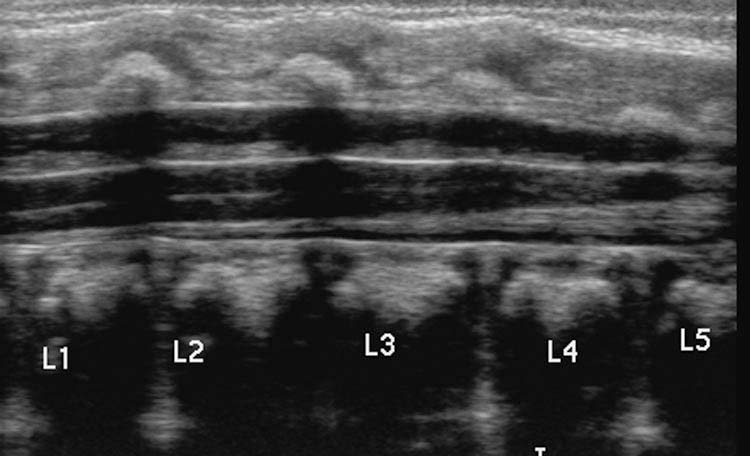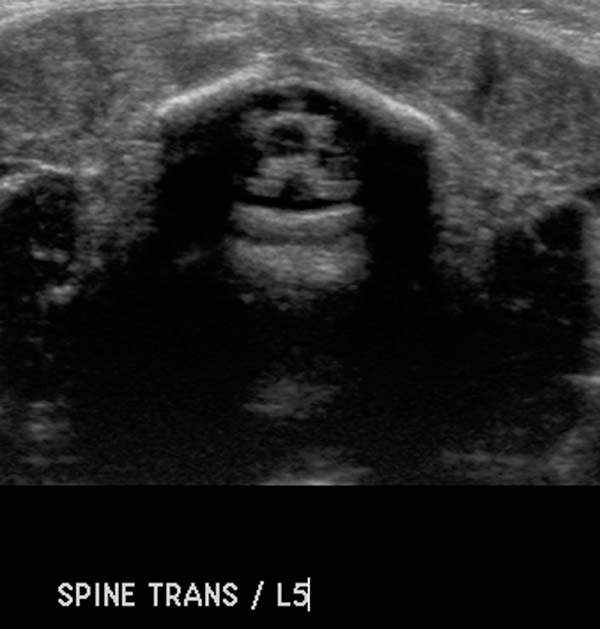Tethered spinal cord syndrome
| Tethered spinal cord syndrome | ||
| ICD-10 | Q06.8 | |
|---|---|---|
| ICD-9 | 742.59 | |
| DiseasesDB | 34471 | |
| MeSH | C16.131.666.680 | |
| Spinal Compression | ||
| MeSH | C21.866.819.678 | |
| Filum Terminate | ||
| MeSH | A08.800.800.720.725.150 | |
Editor-In-Chief: C. Michael Gibson, M.S., M.D. [1]
Synonyms and keywords: Occult spinal dysraphism sequence
Overview
Tethered Spinal Cord Syndrome is a rare neurological disorder (occurring in 0.05 to 0.25 of 1000 births) caused by tissue attachments that limit the movement of the spinal cord within the spinal column. These attachments cause an abnormal stretching of the spinal cord. The course of the disorder is progressive. Symptoms may include lesions, hairy patches, dimples, or fatty tumours on the lower back; foot and spinal deformities; weakness in the legs; low back pain; scoliosis; and incontinence. Tethered spinal cord syndrome may go undiagnosed until adulthood, when sensory and motor problems and loss of bowel and bladder control emerge. This delayed presentation of symptoms is related to the degree of strain placed on the spinal cord over time. Tethered spinal cord syndrome appears to be the result of improper growth of the neural tube during fetal development, and is closely linked to spina bifida. Tethering may also develop after spinal cord injury and scar tissue can block the flow of fluids around the spinal cord. Fluid pressure may cause cysts to form in the spinal cord, a condition called syringomyelia. This can lead to additional loss of movement or feeling, or the onset of pain or autonomic symptoms.
Occult Tight Filum terminale Syndrome
In addition to the 'typical' tethering, there is a more common variation referred to as "Occult Tight Filum terminale Syndrome." This variation whereby the filum Terminale is thickened or has loss of elasticity was first noticed and documented in the late 1800's.
In this variation, the Filum (a piece of tissue or tendon at the base of the spinal cord that joins it to the base of the Backbone) thickens or hardens and causes downward pressure on the spinal cord. This can actually cause scoliosis as well as most of the other symptoms of the more typical tethered cord. [2] This can be diagnosed the same way with the CINE MRI and by checking symptoms.
Diagnosis
- MRI useful in visualizing the conus medullaris, assessing the thickness of the filum terminale, identifying traction lesions, and evaluating associated bony dysraphisms.
- In one study of 25 patients (Raghaven, N. et. al.) in 84% the tip of the conus was below the level of the mid-L2 vertebral body.
- Prone imaging may be useful in patients who have undergone tethered cord surgery or in those in whom clinical suspicion is high while supine MR imaging demonstrated no abnormalities.
- Prone MRI imaging of little value when supine MRI has demonstrated the defect.
- US useful as well: lack of ossification of the posterior arch of the spine in normal infants and the presence of a bony defect in patients with spina bifida permit sonographic examination.
- US may be a useful screening exam.
Treatment
In children, early surgery is recommended to prevent further neurological deterioration, including but not limited to chronic urinary incontinence. In adults, surgery to free (detether) the spinal cord can reduce the size and further development of cysts in the cord and may restore some function or alleviate other symptoms. Tethered Cord Syndrome is causally linked to Chiari Malformation and any affirmative diagnosis of TCS must be followed by screening for Chiari's several degrees. TCS may also be related to Ehlers-Danlos Syndrome which should also be screened for upon a positive TCS diagnosis.
Tethered Cord Syndrome presents varied and almost uncontrollable neurophenomenae in pediatric cases.
Other treatment is symptomatic and supportive. NSAIDs, opiates, synthetic opiates, Cox II inhibitors, off-label applications of tricyclic anti-depressants combined with anti-seizure compounds have yet to prove they are of value in treatment of this affliction's pain manifestations. There is anecdotal evidence that TENS units may benefit some patients.
Treatment may be needed in adults. This version of tight filum is found in adults who were asymptomatic as young adults, but as adults are finding lower back degeneration, scoliosis, neck & upper back problems and developing incontinence and bladder control issues. This syndrome was first noticed in the late 1800's and while information has been available for years, little widespread blind research has been done. More research has been called for and many studies have been done by doctors with great results. There is a low morbidity rate and no known complications have been documented other than those from any type of typical back surgery. The association of this condition with others has been noticed and also needs further research to understand the relations. Spinal compression and the resulting relief is a known issue with this disorder. The filum can also show up with Chiari, sometimes referred to as 'Arnold-Chiari', but most doctors just call it Chiari. (See wiki article on Arnold Chiari for this) This is where the brain is pulled or lowers into the top of the spine.
All information here is a synopsis of an article published in teh March-April 2004 issue of Pediatric Neurosurgery. Issue 40-2-04, issn 1016-2291, 40(2)-51-100 (2004). With permission from the article author, Dr. Monica Wehby. [3]Link to recent article which this information derives.
Prognosis
With treatment, individuals with tethered spinal cord syndrome have a normal life expectancy. However, most neurological and motor impairments are irreversible[1]
References
- ↑ www.answers.com/topic/tethered-spinal-cord-syndrome?cat=health
- "Tethered spinal cord syndrome". National Institutes of Health. Retrieved 2007-11-03.
- "Tethered spinal cord syndrome". Neurosurgery Today. Retrieved 2007-11-03.

